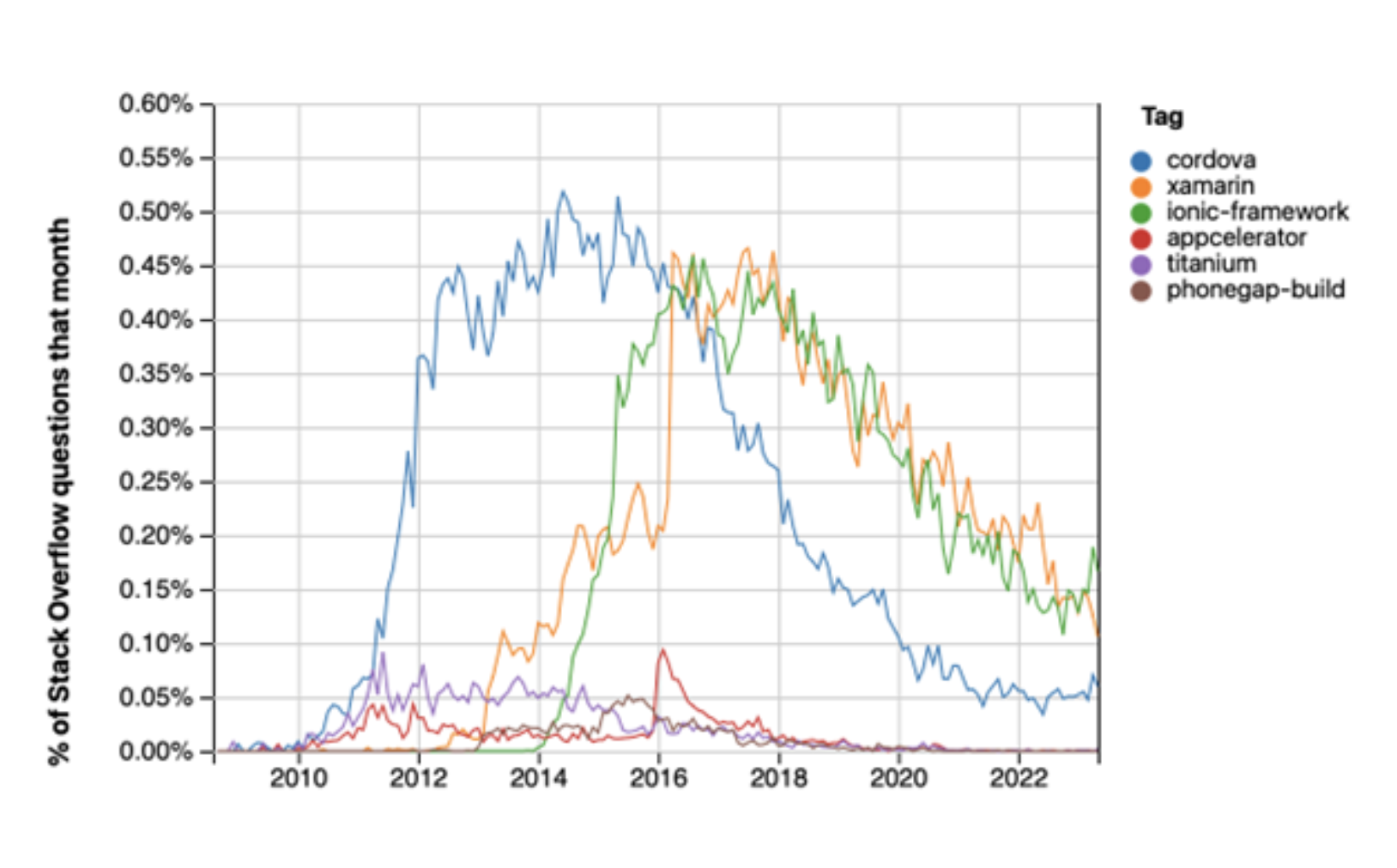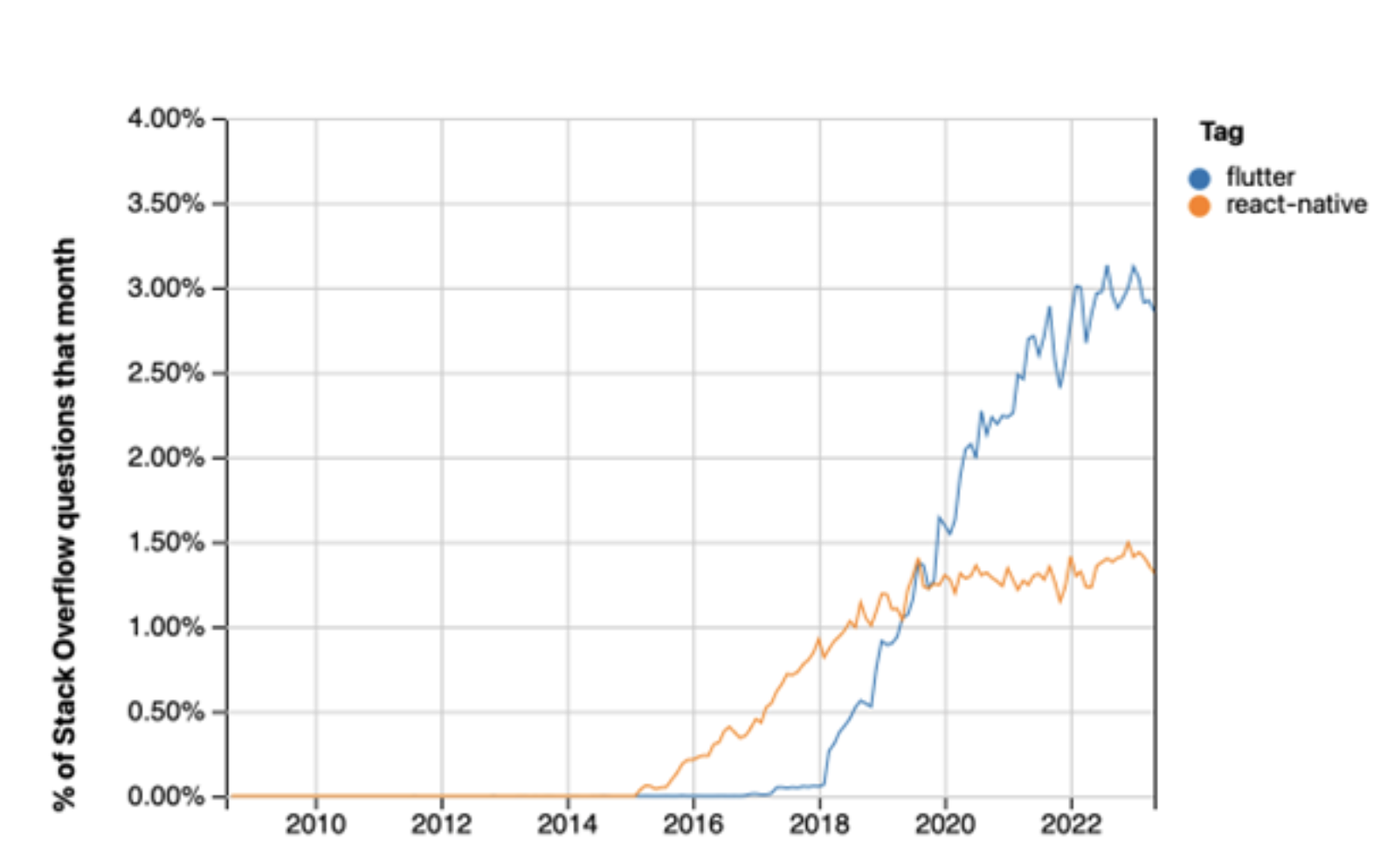
The Rise and Fall of Hybrid/Multiplatform Technologies
Over the years, the mobile app development sphere has been marked by the arrival and subsequent departure of several hybrid/multiplatform frameworks. Names such as React Native, Xamarin, Flutter, PhoneGap, Cordova, Appcelerator, and Titanium have adorned the tech world’s marquee, each promising a revolution in app development, only to recede in popularity after a few fleeting years of success. PhoneGap, for instance, despite its acquisition by Adobe in 2011, halted its maintenance as of 2020, testifying to the transient lifespan of these frameworks.

These technologies, while initially innovative and appealing, eventually succumb to the ever-changing trends, losing their charm for app developers and creators. These recurring patterns underscore the durability and reliability inherent to native application development, which continue to evolve while maintaining their relevance amidst shifting trends.
Stack Overflow is a question-and-answer website focused on computer programming. The above graph (1), created on Stack Overflow, shows the evolution of the percentage of questions asked by internet users about the different multiplatform frameworks over time. For all of them, we notice a peak of interest at their release, followed by a stabilization period before a rapid decline. This illustrates the trend effect that we mentioned earlier.

This other graph (2) compares the same information for the two most recently sought-after multiplatform frameworks: Flutter and React Native. Still the subjects of many questions, they both seem to have recently reached their peak popularity on Stack Overflow.
The Unwavering Power of Native
What sets native applications apart is their direct link to the technology giants themselves – Apple and Google. Native frameworks are published, maintained, and marketed by the very companies selling the smartphones. This is not by chance; it’s a clear indication that these industry leaders hold native app development in high regard, favoring it over other transient frameworks.
This isn’t just hearsay; data-backed studies underline this preference. For instance, an analysis conducted on Stack Overflow, a prominent question-and-answer website focused on computer programming, provides a telling picture. A study of user queries about different multiplatform frameworks over time shows a distinct pattern: a peak of interest at their release, a brief stabilization period, followed by a precipitous decline – a testament to the fleeting fascination developers have with these technologies.
Even the most popular multiplatform frameworks of recent times – Flutter and React Native – are not exempt from this trend. Despite still being the subjects of many questions, data indicates that they may have already reached their peak popularity, signaling a probable decline in the future.
The Longevity Risk and the Native Advantage
The primary issue with hybrid/multiplatform technologies lies in their lack of longevity. Opting for these frameworks entails the risk of choosing a development platform that may no longer be supported in a few years. While this may not pose a significant concern for short-term or disposable projects, for long-term endeavors, the demise of the chosen development framework could necessitate starting app development from scratch, translating into significant time and cost implications.
This is where the inherent advantage of native applications comes into play. Given their robust and consistent support from Apple and Google, native frameworks offer a much more stable and reliable foundation for building apps that are meant to last. Their ability to seamlessly access advanced device-specific features and deliver a superior user experience further substantiates their suitability for sustainable, long-term app development.
Conclusion
In the dynamic, constantly shifting landscape of app development, the stable grounding and reliability offered by native applications unmistakably outshine the fleeting charm of hybrid/multiplatform frameworks. Underpinned by enduring support from technology powerhouses – Apple and Google, native apps unequivocally hold the high ground in terms of long-term viability, performance, and superior user experience. It’s clear that when considering the strategic balance between trend-driven novelty and proven longevity for sustainable, long-term projects, native applications not just triumph but set a benchmark that others strive, yet struggle, to achieve. So, the verdict is clear: when in doubt, go native!

